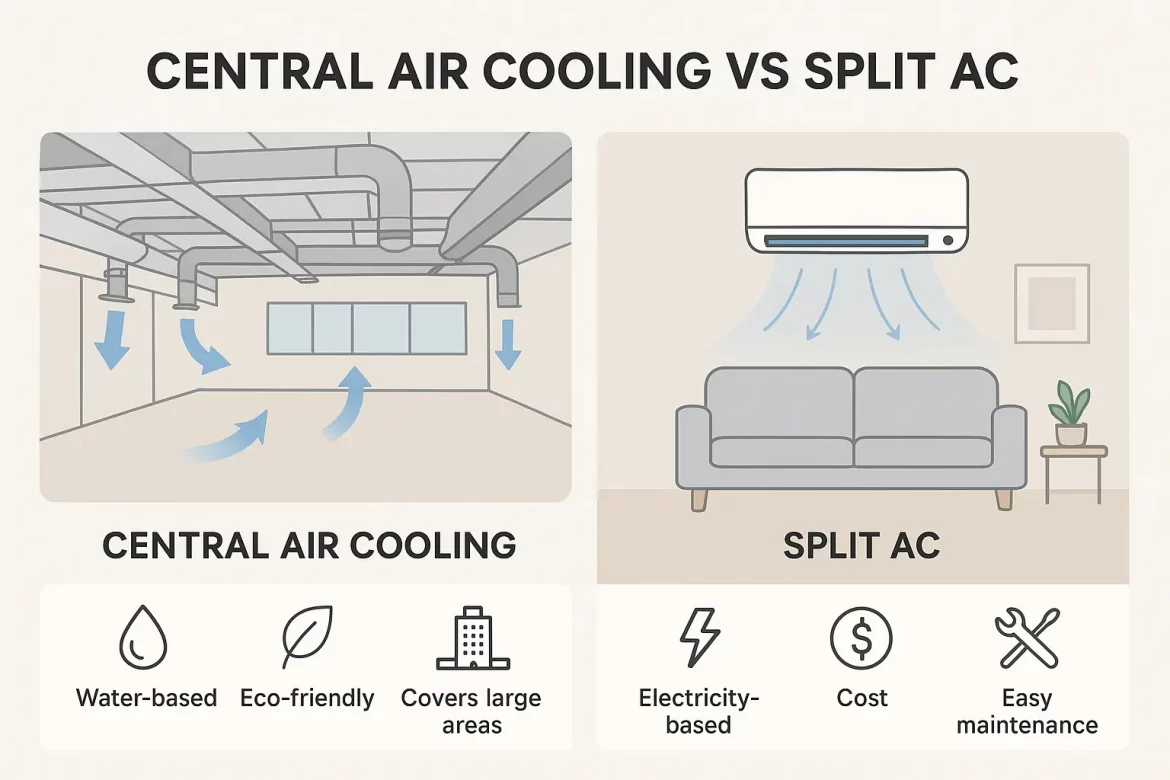Central Air Cooling vs Split AC: Choosing the Right System for Large Buildings in India
If you are planning the cooling system for a large building in India, whether it is a school, factory, shopping mall, or office complex, the choice between central air cooling and Split AC is a significant one. Both systems aim to keep indoor spaces comfortable, but they differ in terms of performance, cost, and suitability for Indian climates.
Let’s break it down so you can make a smart, informed decision.
1. Coverage Area
Central Air Cooling is built for scale. It is ideal for large, open layouts like manufacturing units, auditoriums, educational campuses, and multi-storey buildings. One system can cool thousands of square feet.
Split ACs are better suited for smaller, enclosed spaces, such as cabins, classrooms, or individual offices. For a large building, you need dozens of units. In open-plan buildings, Central Air Cooling is the clear winner. For segmented layouts, Split ACs might be more practical.
2. Energy Efficiency & Running Costs
Central Air Cooling uses evaporative cooling, a technology that consumes up to 80% less electricity than conventional ACs. It is especially effective in hot and dry regions like Madhya Pradesh, Rajasthan, and parts of Delhi NCR.
Split ACs rely on compressor-based refrigeration, which is power-intensive. The more units you install, the higher your electricity bills. If you are looking to cut long-term energy costs, Central Air Cooling is far more economical.
3. Installation & Infrastructure
Central Air Cooling requires ducting, a water supply, and planning during construction or major renovation. Once installed, it integrates neatly into the building’s design.
Split ACs are easier to install individually. But in large buildings, installing 20–50+ units can clutter walls and exteriors with outdoor units not ideal for aesthetics or maintenance.
4. Air Quality & Comfort
Central Air Cooling continuously brings in fresh, filtered, and humidified air, great for maintaining healthy indoor environments, especially in dusty or dry regions.
Split ACs recirculate the same indoor air. Over time, this can lead to dryness and stale air, which is not ideal for comfort or health. For better air quality and comfort, Central Air Cooling takes the lead.
5. Maintenance
Central Air Cooling offers centralized maintenance, duct cleaning, water checks, and periodic servicing.
Split ACs require individual upkeep. Each unit needs filter cleaning, coil checks, and gas refills. In large buildings, this becomes a costly and time-consuming task.
6. Cost Consideration
Central Air Cooling involves a higher upfront investment, but its low electricity consumption and centralized maintenance make it cost-effective over time.
Split ACs may seem cheaper initially, but when scaled up, the combined cost of multiple units and high energy use adds up quickly.
7. Climate Suitability
Central Air Cooling works best in hot and dry climates, perfect for much of central and northern India.
Split ACs perform well in all climates, including humid coastal areas like Mumbai, Chennai, and Kolkata.
Quick Comparison Table
| Factor | Central Air Cooling | Split AC |
| Coverage Area | Large open spaces, multi-floor layouts | Small rooms, cabins |
| Energy Use | 60–80% less power | High, especially with many units |
| Air Quality | Fresh, filtered, humidified air | Recirculated, dry air |
| Installation | Ducting & planned setup | Easy, but messy in bulk |
| Operating Cost | Very low long-term | High recurring bills |
| Maintenance | Centralized | Individual per unit |
| Climate Suitability | Hot & dry regions | All climates |
| Aesthetics | Clean design, hidden ducts | Outdoor units clutter the walls |
Frequently Asked Questions:
Yes. It consumes significantly less electricity, making it more cost-effective for large buildings over time, especially in dry regions.
For open layouts in hot, dry areas like Indore, Jaipur, or Nagpur, Central Air Cooling is ideal. For smaller rooms or humid regions, Split ACs are more suitable.
Absolutely. It pulls in fresh outdoor air, filters it, and adds humidity—unlike Split ACs, which just recirculate indoor air.
High electricity bills and maintenance. Each unit needs separate servicing, and the outdoor units can clutter your building’s exterior.
Yes! Degree Day specializes in designing and delivering customized Central Air Cooling systems for commercial, industrial, and institutional buildings across India.
Choosing the right cooling system is not just about comfort; it is about saving energy, reducing costs, and improving indoor air quality. At Degree Day Pvt. Ltd., we design Central Air Cooling systems tailored for Indian conditions and large-scale applications. Whether you are planning a new project or upgrading an existing setup, our team can help you find the most efficient, sustainable, and cost-effective solution. Contact us today to explore how Degree Day can transform your building into a cooler, cleaner, and more energy-smart space.

